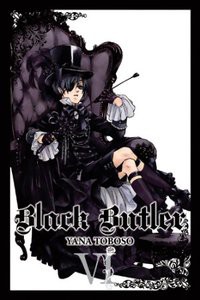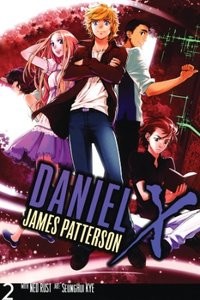RIGHT TURN ONLY!!
Black and Blue
by Carlo Santos,

As a user of an Android tablet and a Linux PC, I have to admit I'm kind of disappointed at how the first few steps into digital manga have mostly been directed at the iPad. Viz is correcting that with their web-based store, and Seven Seas has a few of their original series on Kindle, but for anyone who wants to buy and read manga digitally, it's basically an Apple world out there. Is it so wrong for me to want to "think different"?
BLACK BUTLER

Vol. 6
(by Yana Toboso, Yen Press, $11.99)
FROM THE BACK COVER:
"The cheer of the holidays has passed, but the Noah's Ark traveling circus has been making the rounds, bringing fun and joy to children of all ages. However, as the ringmaster's cries fade away, a disturbing trend begins to surface in the wake of the colorful entourage. Children seem to disappear whenever the circus picks up for its next destination, and there are no clues ... or corpses ... to be found. But when the situation calls for Ciel and Sebastian to infiltrate the big top, will Sebastian's inhuman skills be enough to see him and his young master through a treacherous tightrope act that may well end in death?"
EVIDENCE FOR:
And you thought the curry cooking competition was an unusual departure? Well, here's Ciel and Sebastian Join the Circus! Once again, Yana Toboso finds a creative way to defy the expectations of Black Butler's prim-and-proper setting. Volume 6 explores the world under the Big Top and sprinkles in the series' usual humor: Sebastian gets friendly with a tiger and freaks out the animal tamer; the performers marvel as the butler demonstrates his ridiculous physical dexterity; Ciel gets a serious dose of fish-out-of-water awkwardness as he realizes that the nomadic circus life is nothing like his pampered upbringing. Amidst these amusing escapades, though, there's also suspense and tension lurking in the air: one of Sebastian's supernatural rivals has also joined the circus for shady reasons, and our heroes' investigation of the missing children gets ever more perilous with the troupe watching them. So while the premise seems silly, this plotline has a serious side too. Toboso's deft and delicate art is at its best when Sebastian shows off his skills—throwing and catching knives, swinging on the trapeze, and secretly assisting Ciel. It may not be dashing hand-to-hand combat, but the circus tricks are just as eye-catching.
EVIDENCE AGAINST:
Maybe this is just a stupid, obvious question, but where is the actual plot? What started out as a potential detective thriller gradually turns into a farce as the storyline falls deeper and deeper into Ciel and Sebastian's circus antics. It's understandable that one might need a few scenes to show how our heroes insinuate their way into the troupe, but for that to be the primary focus of this volume—with the actual investigation only beginning late into the final chapter—shows a misplaced sense of priorities. There isn't even any kind of forward progress where Ciel develops his performing skills or gets acclimated to his surroundings; it's just "here's an aristocrat in an unlikely situation, so let's all laugh at him!" And Sebastian, already being a god-like character, is just there to be ridiculously good at everything ... which doesn't really advance the story either. Visually, the occasional bursts of action do little to spice up an otherwise repetitive sense of layout: it's always a few panels of dialogue, maybe a character performing some action, and a comedic punchline if you're lucky. This happens for almost two hundred pages and goes nowhere ... until it's too late.
FINAL VERDICT:
Well, that was a thorough waste of time. Maybe they'll figure out where the missing kids went next volume? Because this one was a cute but pointless C-.
BLUE EXORCIST

Vol. 3
(by Kazue Kato, Viz Media, $9.99)
FROM THE BACK COVER:
"As a new Exorcist Esquire at True Cross Academy, Rin Okumura has a long way to go before he reaches the top rank of Paladin. When Rin and his classmates are sent to search for a ghost, Amaimon, the King of Earth, takes Rin by surprise and steals the Koma sword. Higher powers have been observing events at the academy and make their presence known. New players enter the game, and Rin doesn't even know he's playing!"
EVIDENCE FOR:
The universe of Blue Exorcist continues to expand as it hits the pivotal third volume, proving that there's a serious story here and not just throwaway demon-of-the-week action. The middle chapters, in particular, are full of surprises: Rin has a direct confrontation with one of the "big bosses," shady classmate Yamada turns out to be more than just a classmate, and a longstanding beef between True Cross Academy and the Vatican itself is revealed. (The series borrows heavily from Judeo-Christian folklore; is it any surprise that the political side would show up eventually?) What this all means is that the plot suddenly just got a whole lot more complex—and a whole lot more interesting. Those more curious about Rin's human side will also appreciate all the flashbacks with Father Fujimoto, who continues to be a warm, fatherly presence despite being dead since Volume 1. Parental love really does help to soften a hard-edged action series. The fight scenes are thrilling as always, especially when Rin releases his powers, and the background art really gives the series a sense of place. From amusement parks to underground headquarters to deep forests, every detail makes the Blue Exorcist world feel complete.
EVIDENCE AGAINST:
Sure, the backgrounds look great ... when Kazue Kato feels like drawing them. This volume makes the same mistakes as the last two, with a few too many scenes where the characters appear to be chatting with each other in blank white space. For a series with such a slick visual style, that kind of laziness is simply out of place. Sometimes the storyline also settles for third-rate quality, like the chapter about the demon cat Kuro—it may be cute, but adds little plot or character development, aside from introducing an animal sidekick that only shows up one other time in this volume. At least the other new character that's introduced, Shura, plays a pivotal role, but her extremely fanservice-driven wardrobe and clichéd "butt-kicking girl" personality is sure to raise a few eyebrows. Meanwhile, some action scenes stop short of greatness because they get fragmented and mixed up with what the other characters are up to: Rin's amusement park chase, for example, gets spliced with Shiemi's own adventure, diluting the impact of both situations and making a mental juggling act out of trying to follow multiple characters.
FINAL VERDICT:
Aside from that pointless cat chapter, the rest of Blue Exorcist is still a grand adventure solid enough to earn a B.
MAOH: JUVENILE REMIX

Vol. 6
(by Kotaro Isaka and Megumi Osuga, Viz Media, $9.99)
FROM THE BACK COVER:
"In Nekota City, Inukai and his team of vigilantes, known as Grasshopper, protect the citizens from a rising crime wave and the greedy hands of businessmen bent on turning every block into a modern strip mall. But is this public hero actually a devil in disguise? And can high school student Ando use his mysterious power of 'ventriloquism' to uncover the truth before it's too late?
As Ando continues to try to uncover Inukai's plans, Grasshopper prepares for a major event to take control of the city. And just when Ando gets to close to the truth, standing in his way is the most dangerous challenge he's ever faced."
EVIDENCE FOR:
No more wishy-washy arguments about the moral course of action. No more weird assassins skulking around. Maoh: Juvenile Remix finally gets focused in Volume 6, as Ando sets out to stop Inukai's vigilante ways ... and gets into an incredible, hundred-page chase-and-fight scene because of it. His confrontation with Inukai's chief minion, the telekinetic bartender, is as heart-pounding as they come—not just because it's psychic power against psychic power, but because of the clash of ideals. Witness the war of words between Ando and the bartender at the construction site—individualism vs. tribalism, free will vs. control—an experience that's just as gripping as the actual, physical battle. And when it finally does come down to who wields their powers the best, the victory doesn't go to the guy who screams the loudest: rather, it's all about outsmarting your opponent. But just because Maoh's best battles are fought in the mind doesn't mean that it's lacking in action; the impactful page layouts, high-speed chases, and Ando's numerous escapes from death are all as thrilling as any conventional action series. Really, what could be better than a story that's intense on both a visual and cerebral level?
EVIDENCE AGAINST:
If the fight between Ando and the bartender is so galvanizing, why does it take almost five chapters to get there? The lead-up to the big battle is this volume's biggest misstep, almost boring readers to death with pointless, wild-goose-chase antics before the good stuff starts. "Where is Inukai's meeting?" is the big plot point here, but with all these cryptic clues being dropped and the characters quoting Kenji Miyazawa at each other, it starts to look more like self-indulgent literature-student drivel than actual storytelling. It's one thing to set up a vague, mysterious plot thread; it's another to parade that plot thread in front of everyone until they're tired of hearing about how mysteeerious it is. If that's not self-indulgent enough, the early chapters also kick around the same old social-studies arguments about how the Anderson Group's money-making intentions are evil, but forming angry mobs and beating up anyone who disagrees with you doesn't exactly solve the problem, etcetera etcetera. While these are central themes to the main story, the point has been made and it's time to move on. Which finally it does from Page 80 onwards.
FINAL VERDICT:
This volume stumbles out of the gate, but a strong second half and dramatic finish redeem it for a suspenseful, action-packed B.
NURA: RISE OF THE YOKAI CLAN

Vol. 4
(by Hiroshi Shiibashi, Viz Media, $9.99)
FROM THE BACK COVER:
"While the day belongs to humans, the night belongs to yokai, supernatural creatures that thrive on human fear. Caught between these worlds is Rikuo Nura. He's three-quarters human, but his grandfather is none other than Nurarihyon, the supreme commmander of the Nura clan, a powerful yokai consortium. So, Rikuo is an ordinary teenager three quarters of the time, until his yokai blood awakens. Then Rikuo transforms into the future leader of the Nura clan, leading a hundred demons.
The Nura clan's turf has been invaded! A mysterious set of travelers arrives in Ukiyoe Town to wreak havoc and challenge Rikuo in his position as the leader of Japan's most powerful yokai syndicate. They even infiltrate his school! If Rikuo wants to maintain the Nura clan's status and protect his human friends from the rival yokai's malice, he's going to have to call his hundred demons to battle and prepare for his biggest fight yet!"
EVIDENCE FOR:
They say Japan is the land of eight hundred million spirits. I'm starting to suspect Hiroshi Shiibashi has all of them stored in his head. Nura Volume 4 is another outpouring of folk monsters and ancient sorcery, each one more striking than the last: the statue-headed Sodemogi would be almost comical if his power weren't so eerie (he tugs on your sleeve, and if you turn around to look, you die); in the second half, an Inugami (dog-god) intrusion turns epic as the beast morphs into a giant wolf. The only thing more impressive than these creatures is the visual style in which they're rendered—the painterly brushstrokes, the deep dark shadows—and the hot-blooded battle scenes as Rikuo and company take them down. But Shiibashi doesn't just toss these fights out there as abstract events; each one is also grounded in a story surrounding the main characters, whether it's a sick relative or a school election campaign. That last one even weaves in a bit of dramatic irony as the students think the yokai attack is part of someone's campaign speech—but Rikuo and company know better, as do all of us who are pulled into the battle.
EVIDENCE AGAINST:
Indeed, Shiibashi makes all the right moves in making the fights as impressive as possible. And tying the yokai world's machinations to the daily lives of the human characters gives everything a sense of connectedness. So why does the series still feel so empty? Maybe it's because of the huge supporting cast that readers have barely gotten to know—every time another Nura ally arrives on the scene, it always seems to be "that guy I vaguely remember from that story arc before." Even familiar folks, like the yokai posing as Rikuo's schoolmates, only appear briefly to state that they are lending their support—then wander off until their services are needed. That's no way to get to know the characters in the Nura universe, and explains why the fights still feel so detached from whatever else is happening in the series. The Inugami battle, in particular, becomes so huge in scope that it overshadows the plot point that triggered it in the first place: the invasion of the Shikoku demon clan. The frequently cluttered layouts, with characters running around and yelling in seemingly every corner of every page, also adds to the feeling that the series could use some clean-up.
FINAL VERDICT:
It's a great supernatural action series, no doubt. But if supernatural action is all it has to offer—with little depth to the characters or storyline—then it remains a C.
TORADORA!

Vol. 2
(by Yuyuko Takemiya and Zekkyo, Seven Seas, $10.99)
FROM THE BACK COVER:
"Takasu Ryuuji thought that his ill-fated streak had turned around now that he was in his second year of high school sitting next to the girl of his dreams, Kushieda Minori. Ryuuji was wrong; for after unwittingly crossing the most feared and fearsome girl in school, Aisaka Taiga, everything went off the deep end!
It's taken time, but Ryuuji and Taiga have slowly found some common ground and can at least tolerate each other (just a little). The problem is, Fate just doesn't seem to throw Ryuuji a bone. Everyone in Ryuuji's class is now convinced that he and Taiga are dating—even Minori! And to make matters even more embarrassing, Minori has given Ryuuji and Taiga her blessings. How's Ryuuji ever going to win Minori's heart now?!"
EVIDENCE FOR:
Even as the relationships get more complicated in Volume 2, Toradora! is still basically about the ups and downs of high school love. So how does one make this common topic interesting? By giving all the charactesrs outlandish facial expressions and making them behave like loons, of course! Yes, that's actually a good thing, because it fills Toradora! with a liveliness and spark that we sometimes fail to express in our own lives. Who can forget Ryuuji and Taiga's looks of shock when Minori gives them her "blessing," or the epic pole-kicking scene when Taiga finally lets out her frustrations? Truly, Zekkyo's artistic exaggerations—whether through changes in character design, or with vicious strokes of black marker—is the series' hidden life source. Physical comedy aside, though, there are some seriously charming moments as well—the ill-fated confession scene between Taiga and Kitamura is handled with all the heart and elegance a youthful romance can muster, and subtext about Taiga's obvious affection for Ryuuji makes it all the sweeter. The arrival of the gorgeous but poison-tongued Ami in the later chapters also adds a new wrinkle to the storyline that promises plenty more ups and downs to come.
EVIDENCE AGAINST:
People in love always overthink things. Even worse is when their thoughts spill out into words, and we get the waterfalls of dialogue that Toradora! often resorts to. Does it really take that many words for Taiga and Ryuuji to express their frustrations about their love lives? Apparently, yes, and the result is a story that is often slowed down by its own wordiness. The plot is also sapped of its energy by dalliances like a summer interlude between Taiga's confession and Ami's arrival—a couple of chapters where nothing really happens except Taiga and Ryuuji arguing like they always do. It's cute, maybe, but surely those characters already talk enough as it is. Because of this mindless plot-churning, the whole point that Taiga and Ryuuji like each other but won't admit it is all but driven into the ground, being the default message when the story has nothing else to say. The artwork also has a certain "default mode"—the plain, soulless backgrounds that crop up for lack of anything interesting to draw. Perhaps the characters stand out, but the dull school interiors and suburban streets certainly don't.
FINAL VERDICT:
Although it sometimes wastes too many words and too many scenes to say the same thing, there's just so much energy and heart to this story that it still picks up a B+ for being that much fun.

DANIEL X

Vol. 2
(by James Patterson with Ned Rust and SeungHui Kye, Yen Press, $12.99)
FROM THE BACK COVER:
"In the sleepy town of Holliswood, a twisted alien TV producer is using his powers to throw the town into chaos—and documenting every minute of it. Fresh from his victory over Number 6, Daniel X is the only one who can stop this made-for-TV tyrant, but the devilish director has other plans. He wants to film the most spectacular finale the world has ever seen, starring Daniel himself! Can the Alien Hunter take down this deranged outlaw, or will he find himself on the cutting room floor?"
EVIDENCE FOR:
With introductions and origin stories out of the way, Daniel X dives right into the action this time. Volume 2 is a nonstop thriller from cover to cover, using the classic catch-me-if-you-can formula to keep the suspense alive: either Daniel figures out how to defeat his alien foe, or all of humanity ends up being a casualty in a sick intergalactic reality show. There's certainly an element of pop-culture satire to this premise, with its pointed take on sleazy TV productions, consumer culture, and our addiction to electronic entertainment devices. But in the end, it's Daniel's race against time to catch the alien known as Number 5 that really drives this story; the constant feeling of being chased and a number of well-timed set pieces fill each chapter with adrenaline. There's an emotional undercurrent as well, with a couple of plot points connected to the death of Daniel's parents as a reminder of why he became an alien hunter in the first place. Seunghui Kye's art brings out the outlandishness of Daniel's alien opponents, with freakish animal hybrids and some decidedly skin-crawling "breeding grounds." Clean, uncluttered layouts also keep the visuals moving at a fast pace.
EVIDENCE AGAINST:
Although Kye's artistic style is highly polished, it often lacks that layer of nuance that would really bring a story to life. Backgrounds often look flat and fake due to a lack of texture, and the characters—although distinctive in appearance—often have a stiff appearance to them, like they were copied out of a character design manual instead of being real actors in a story. But the real disservice to cast of Daniel X is the way they're treated as supporting characters: most of the time, Daniel's buddies only show up as a helping hand when he needs to fend off some aliens. What about developing some emotional bonds here and there, fellas? (Then again, that may be too much to expect when all the people in Daniel's life are products of his ability to manipulate matter.) The storyline itself is also another boilerplate Patterson creation, moving from Point A to B to C as Daniel uncovers clues, fights various foes, and reaches the predictable showdown with the big boss. Naturally, Daniel's "clever solution" is the kind that a middle-schooler might dream up for a creative writing project. Don't we deserve better from a world-famous author?
FINAL VERDICT:
It isn't any kind of sci-fi masterpiece, but if suspenseful cat-and-mouse games and head-to-head fights with evil aliens sound like fun, this one's got plenty of it.

This week's Reader's Choice looks at one of the definitive shoujo works of all time ... and no, we're not talking about the Sailor Moon re-release that everyone is hyperventilating for. In fact, this one can be bought in omnibus form right now! Here is Zoya Chadha's look at a classic title that should be familiar to all.
MAGIC KNIGHT RAYEARTH

(by CLAMP, Dark Horse, $19.99 ea.)
Most are already aware of the fact—be it the sparkly magical girl exploits of Cardcaptor Sakura, or the mind-numbing complexity of Tsubasa: Reservoir Chronicle—the fantasy genre is what CLAMP works best with.
But before these titles was an RPG-style heroine tale like no other, which was snapped up by the now-defunct Tokyopop more than a decade ago. Dark Horse has laid claim to it since then, along with a handful of other titles, providing great relief to CLAMP fans.
Magic Knight Rayearth begins when three junior high school girls hear a voice asking them to save a world called Cephiro. The voice belongs to Princess Emeraude, the Pillar whose will maintains the peace of this magical world where belief is power. But the peace in Cephiro is now threatened as Princess Emeraude is imprisoned and monsters begin to invade the land. With her last bit of strength, the princess summons forth the three girls destined to become the Magic Knights in the hopes of saving her world.
Initially, the only thing on the girls' minds is to return safely to Tokyo—but bonds of friendship are quickly forged, and a growing attachment to the world where belief is everything, as well as fondness for the people living in it, ensures that their journey will go well beyond that.
An amazing feature of CLAMP's works is prevalent: the characters are strong, and their strength grows throughout the story, to reach amazing heights. No one is shallow—the so-called villains, in particular, have their own agendas—after all, evil never considers himself to be evil (and, in CLAMP's case, is often not).
What appears to be, at first glance, a relatively simple story is not so: it develops beyond a fight between good and evil, resulting in startling revelations which will change the Magical World of Cephiro, as well as the protagonists' lives, forever.
The art is excellent—reality blends into fantasy with a flourish of sweeping lines.
With a story that is impossible to not grow attached to, Magic Knight Rayearth is a must have for any lover of the fantasy/magical girl genres. A solid addition to any shelf.
Is there a hidden gem of manga you'd like to reveal to the world? Is there a piece of garbage that deserves to be bashed in public? Or is there a title that didn't get a fair grade here, and you want to set the record straight?
Now's YOUR chance to be the reviewer! Write a review of about 300-400 words (a little more or less is fine) and include:
- Your name
- Title of manga (and volume no., if applicable)
- Author/Artist
- Publisher
- Briefly describe the story, then explain why this manga is great, terrible, or in between. Be objective, but also be entertaining.
Then send it in to rtoreaders (at) gmail (dot) com (plain text format preferred). One review will be selected out of all the submissions and will be published in the next column. All types of manga and manga-inspired comickry are accepted, from past and present, from Japan and beyond—what matters is that it's the Reader's Choice! NOTE: Submissions may be edited for formatting and grammar.
discuss this in the forum (11 posts) |